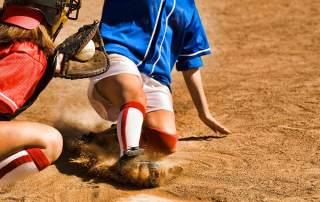Common High School Baseball Injuries and Where to Catch a Baseball Game!

With baseball season on the doorstep, it’s a good time to take notice of the risks baseball presents, particularly for children in high school. Now, we’re not suggesting for a second (gasp!) that you should stop your child playing. We’re just presenting the facts to ensure you know the statistics and are prepared for all possibilities. And, of course, that you’re educated about what to do in the case of baseball injuries.
With baseball season on the doorstep, it’s a good time to take notice of the risks baseball presents, particularly for children in high school. Now, we’re not suggesting for a second (gasp!) that you should stop your child playing. We’re just presenting the facts to ensure you know the statistics and are prepared for all possibilities. And, of course, that you’re educated about what to do in the case of baseball injuries.
Types of Common High School Baseball Injuries
Americans get more than 627,000 baseball-related injuries each year, according to the U.S. Consumer Products Safety Commission. Of those injuries, almost two-thirds take place in children aged 5 to 14 years, and the majority of them are high school injuries.
The types of injuries found among high school baseball players cover a wide range, including:
- Shoulder injuries
- Elbow, hand or wrist
- Ankle and knee injuries
- Facial injuries, such as eye or mouth trauma
Injuries ranged from bursitis through strains, sprains, abrasions, muscle cramps, tendonitis and fractures, with inflammation and torn ligaments bringing up the rear.
Causes of High School Baseball Injuries
A full one-third of all baseball injuries studied by the Commission were caused by players sliding into bases, and these were mostly ankle and knee injuries. Shoulder injuries are commonly caused by throwing, catching or swinging the bat, and while sometimes these are acute injuries caused by a sudden impact, they are equally often simply a result of overuse of the joint during play.
Getting Treatment for High School Baseball Injuries
When your child follows a baseball game with a complaint of pain in one of his limbs, it’s important to take him to a freestanding ER for evaluation. Baseball has one of the highest fatality rates of all sports, although 77% of injuries are minor enough that the victims can play again within 7 days. It’s not a chance you want to take, however, particularly with head or facial injuries or an arm or leg that could be sprained.
Your physician will examine the site of the injury and perform various tests to determine the severity of it, and to establish whether there is a risk of complications. He (or she) may prescribe anti-inflammatory medication, painkillers, physical therapy or a combination of care to treat your child’s condition. In the case of broken bones or fractures, surgery may be required to set the bone correctly.
Tips for Preventing High School Baseball Injury
The best cure is always prevention, so teach your child to avoid baseball injuries where possible. Some ways to do this are by:
- Getting a pre-season sports physical, which will help you to identify any potential orthopedic issues your child has before they become problematic.
- Learning to warm up and stretch thoroughly before every game and practice session. This increases your child’s heart rate, which boosts blood circulation to the muscles, tendons and ligaments and helps to protect him against injury.
- Doing a “field inspection” before the game begins, and identifying any uneven patches of turf, broken glass and other debris that can cause trips, falls or cuts.
- Learning the basics of first aid, as well as having access to a first aid kit and a supply of ice packs to use on any muscle cramps or strains as they occur.
- Checking that all sports equipment fits the player correctly and is worn and fastened the right way.
Catastrophic injuries in baseball are rare, fortunately, and the use of safety gear such as helmets, eye protectors and face masks has helped to make the game safer for all players. High schools can also help to reduce the number of injuries that happen while sliding into the bases by using breakaway instead of stationary bases.
Teach your child to play safely and have fun, and if you want to know where you can catch a high school baseball game in the Mission Bend area, check out some of these upcoming schedules:
During February, Elsik Rams Varsity games include opponents Aldine, Westfield, Northbrook, Humble and Dulles. As part of the Alief Tournament, they’ll be playing Houston Chavez, Houston Christian, Emery Weiner and Northbrook.
Hastings Fighting Bears, meanwhile, will play Westbury, Terry, Bush, Chavez, Galina Park and Aldine, and for the February portion of the Alief they’ll be up against Northbrook, Emery Weiner, Dickinson and Chavez.
Taylor is playing Nimitz, Cy Springs, Wheatley and FB Travis, with the February Alief games against Pasadena Memorial, FB Bush, Northbrook and Cy Lakes.




